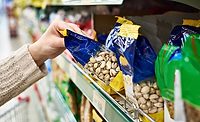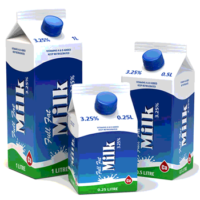The Regulation of Active and Intelligent Food Packaging in the U.S. and the EU
Innovations in A&I food packaging, if allowed to advance, could significantly reduce food waste and improve food safety

Photo credit: Highwaystarz-Photography/iStock / Getty Images Plus via Getty Images
One-third of all food produced in the world, or approximately 1.3 billion metric tons (1.43 billion tons), is lost or wasted every year.1 In the U.S. alone, an estimated 133 billion pounds of food, at a value of USD $161 billion, is wasted yearly.a
The U.S. Environmental Protection Agency (EPA) provides the following definitions for food waste and food loss:
- Food waste refers to food such as plate waste (i.e., food that has been served but not eaten), spoiled food, or peels and rinds considered inedible that is sent to feed animals, to be composted or anaerobically digested, or to be landfilled or combusted with energy recovery.
- Food loss refers to unused product from the agricultural sector, such as unharvested crops.2
Efforts to reduce food waste are multifaceted and include increased diversion of food to food banks, education and outreach, and efforts to standardize date markings on food labels. Another way to reduce food waste is through the use of active and intelligent (A&I) packaging. The publication, "A Roadmap to Reduce U.S. Food Waste by 20 Percent,"3 notes the link between climate change, natural resource depletion, and food waste, and suggests that using A&I packaging to prolong product freshness and slow the spoilage of perishable fruit and meat has the potential to prevent 72,000 tons of food waste with an economic value of USD $167 million.
If innovations in packaging such as these are allowed to advance, the impact of these products could be of benefit, not only in reducing food waste but also in improving food safety.
Active Packaging
Active packaging systems protect food from contamination or degradation either by creating a barrier to outside conditions or by controlling the atmosphere within the package. As a result, the degradative reactions of lipid oxidation, microbial growth, and moisture loss are stalled, thereby extending the shelf life of the food inside the package.
Active packaging can involve components, either added to the packaged food in small sachets or incorporated into the packaging materials, which release or absorb substances into or from the foods or the surrounding environment to improve the safety and/or maintain the nutritional quality and sensory properties of the food. Absorbers remove substances such as moisture, carbon dioxide, oxygen, and ethylene, while emitters can add antimicrobial compounds, carbon dioxide, antioxidants, flavors, ethylene, or ethanol.
The current trends of reduced processing and using fewer additives, and increasing supply chain demands are, in part, behind research on active packaging intended to reduce food waste and improve food safety. Innovative active packaging technologies are at varying stages of development. Examples of current research include:
- Techniques for infusing food-grade natural extracts into film or containers that release controlled active vapor in food
- Non-migratory active packaging or the immobilization of preservatives in packaging material, which can inhibit spoilage bacteria while reducing the level of preservatives required to be added directly to foods
- Active packaging using bio-based materials, such as infusing packaging made from zein (a type of corn protein), starch, and other naturally derived biopolymers with natural antimicrobial compounds (i.e., oil from thyme and citric acid).
Intelligent Packaging
Intelligent packaging may contain an external or internal indicator to provide information about aspects of the history of the package (such as passage of time and temperature at which the food was kept) and/or the quality of the food (such as evidence of spoilage and freshness). Materials used in intelligent packaging do not have an effect on the food; they only convey information about the condition of the food or its surroundings.
Intelligent packaging systems are generally classified into three categories: sensors, indicators, and radiofrequency identification (RFID) systems. These can include QR code/colorimetric indicators for monitoring freshness of food or degradation sensors that are capable of measuring a product's decay.
Beyond reducing food waste or helping ensure food safety, intelligent packaging also can track the location and condition of food, thereby facilitating transfers of food to those in need, linking nutrition to consumer health needs, mimicking the growth kinetics of pathogens like Escherichia coli, and reducing food fraud.
Regulation of A&I Packaging in the U.S.
In the U.S., active and intelligent packaging are regulated under the Food and Drug Administration's (FDA's) regulatory framework and subject to the same requirements as all food-contact substances. Materials used in food-contact applications are subject to premarket regulatory clearance in the U.S if deemed "food additives."
A "food additive" is defined in the Federal Food, Drug, and Cosmetic Act (FD&C Act) as a substance that is reasonably expected to become a component of food under the intended conditions of use.4 Food additives that result from incidental exposure from a package are considered indirect food additives (i.e., those not added directly to the food). Statutory exemptions from the "food additive" definition are provided for substances that are generally recognized as safe (GRAS) or subject to an exception or exclusion listed in the FD&C Act.
Chemicals or scavengers can be added to food packaging with the aim of reducing the spoilage rate of food, or to maintain some characteristic of the food. The Code of Federal Regulations (C.F.R.) anticipates that some food additives may be added to packaging with the intent to have a physical or technical effect on the finished article.5 The regulation specifies that these additives shall not exceed, where no limitations are specified, the amounts required to accomplish the intended physical or technical effect in the food contact article.
In summary, generally speaking, if materials in A&I packaging systems do not migrate to the food or have a technical effect on the food, then there are no special regulatory concerns. However, manufacturers must account for any additional migrants, decomposition byproducts, or impurities that may occur as a result of the chemical activity in the active packaging material during its storage and shelf life.
With respect to additives in A&I packaging that are intended to have a technical effect on the food itself, these substances may need to be evaluated as direct food additives. An example is enzymes added to the inside of citrus juice packaging to degrade the bitter compounds in the juice. On the other hand, a sanitizing solution used on the interior walls of a package for sterilization purposes are typically evaluated by FDA as indirect additives.
Importantly, antimicrobials that are part of, or used in, packaging add a regulatory consideration. Jurisdiction over the safety of antimicrobial pesticide residues used in or on food packaging materials falls under the purview of FDA; however, under the Federal Insecticide, Fungicide, and Rodenticide Act, these products may also need to be registered with the U.S. Environmental Protection Agency (EPA). Furthermore, when antimicrobial activity on packaging is intended to be ongoing, EPA exercises jurisdiction over food safety issues in addition to regulating the safe use and efficacy of the antimicrobial itself.
Regulation of A&I Packaging in the EU
In the EU, A&I packaging that is intended to contact food is regulated pursuant to Regulation (EC) No. 450/2009.7 This regulation establishes a premarket approval system in which A&I materials may not be marketed unless the individual substances responsible for the active and/or intelligent function are included on the European Community list of eligible substances, with some limited exceptions. In addition, A&I materials, as well as their component substances, must be accompanied by a written declaration of compliance at every stage of marketing other than just the final sale.
The A&I Regulation defines "active materials and articles" as "materials and articles that are intended to extend the shelf life or to maintain or improve the condition of packaged food; they are designed to deliberately incorporate components that would release or absorb substances into or from the packaged food or the environment surrounding the food." It defines "intelligent materials and articles" as "materials and articles which monitor the condition of packaged food or the environment surrounding the food."
Under (EC) No. 450/2009, A&I materials may only be placed in the market if they are suitable for the intended purpose; comply with general safety requirements applicable to all food-contact materials and with specific requirements applicable to A&I materials and articles; and comply with the composition, labeling, and declaration requirements of the regulation.
The exceptions from the requirement that only substances included on the Community list of authorized substances are:
- Released active substances, which must comply with the relevant Community and national provisions applicable to food, including the Framework Regulation
- Other substances falling within the scope of Community or national provisions applicable to food, which are added to or incorporated into active materials to have a technological effect on the packaged food
- Substances used in components that are not directly in contact with food or the environment surrounding the food and are separated from the food by a functional barrier, provided that they are not mutagenic, carcinogenic, toxic to reproduction, or deliberately engineered to particle size with functional physical or chemical properties that significantly differ from those of their larger-scale counterparts.
The amount of a released active substance is not included in the value of the measured overall migration when an overall migration limit (OML) is established for a food contact material into which the component is incorporated. Substances used in components that are not in direct contact with food or their surrounding environment are restricted to a migration level of 0.01 mg/kg for each group of substances related in structure and toxicological characteristics.
The safety of A&I substances for use in food packaging must be evaluated by the European Food Safety Authority (EFSA) before their use in the EU can be authorized. EFSA's Panel on Food Contact Materials, Enzymes, Flavorings, and Processing Aids (CEF) initially published guidelines on submitting a dossier for the safety evaluation of A&I substances present in A&I materials and articles intended to come into contact with food in July 2009. A revision of those guidelines7 was endorsed on September 9, 2020, and the revised version was implemented on March 27, 2021.
The guidelines explain that safety assessments will focus on the risks related to the dietary exposure to chemicals due to:
- The migration of the active and/or intelligent substance(s)
- The migration of their degradation and/or reaction products
- Their toxicological properties.
They also point out that A&I substances behind a functional barrier do not need a safety evaluation and are outside the scope of Regulation (EC) No. 450/2009. While Regulation (EC) No. 450/2009 officially came into force on June 18, 2009, the provisions relating to composition will not take effect until the Community list of eligible substances is published. Until then, the relevant national provisions will continue to apply.
As new A&I packaging technologies find their way into global markets, legislative and regulatory issues must be considered. This will involve giving careful consideration to new substances used in A&I food packaging and their potential impact on the food contained inside the package.
Note
a Since this article was originally published, ReFED reported that in 2022, 156 billion pounds of food, at a value of $428 billion, was wasted in the U.S. “Food waste” is defined as uneaten food and inedible parts (e.g., peels, pits, bones) going to: composting, anaerobic digestion, landfill, combustion, sewer, dumping, spread onto land, or not harvested. (See Food Waste Problem | ReFED for more information.)
References
- United Nations Environment Program. https://www.unep.org/.
- U.S. Environmental Protection Agency. 2021. "Sustainable Management of Food Basics." https://www.epa.gov/sustainable-management-food/sustainable-management-food-basics.
- ReFED. "A Roadmap to Reduce U.S. Food Waste by 20 Percent." 2016. https://nrcne.org/wp-content/uploads/2019/12/ReFED_Report_2016.pdf.
- U.S. Food and Drug Administration. Federal Food, Drug, and Cosmetic Act. Sec. 201(s). April 23, 2021. https://www.govinfo.gov/content/pkg/COMPS-973/pdf/COMPS-973.pdf.
- Code of Federal Regulations (C.F.R.) § 174.5. "General provisions applicable to indirect food additives". https://www.ecfr.gov/current/title-21/chapter-I/subchapter-B/part-174/section-174.5.
- European Commission. Commission Regulation (EC) No. 450/2009 on active and intelligent materials and articles intended to come into contact with food. May 29, 2009. https://eur-lex.europa.eu/legal-content/EN/TXT/?uri=CELEX:32009R0450.
- European Food Safety Authority. "Guidelines on submission of a dossier for safety evaluation by the EFSA of active or intelligent substances present in active and intelligent materials and articles intended to come into contact with food." EFSA Journal 1208 (2009): https://efsa.onlinelibrary.wiley.com/doi/pdf/10.2903/j.efsa.2009.1208?__cf_chl_jschl_tk__=C6CN0gh5qWkwSz8jGBIivMlszzPrwaysXcOrsTzq0ZQ-1642538455-0-gaNycGzNDOU.
George G. Misko, Esq., is a partner in the Washington, D.C. office of Keller and Heckman LLP.
Looking for a reprint of this article?
From high-res PDFs to custom plaques, order your copy today!







